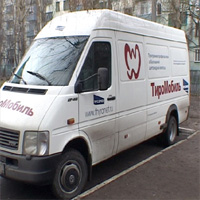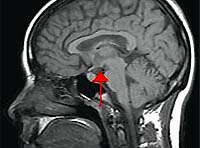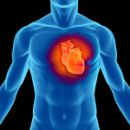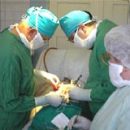What is Kushing's disease? What are the symptoms of Cushing's disease? How to diagnose and treatment of Cushing's disease? Answers to these questions you will find in the article.
Content
Kushing's disease
Signs of this disease were first described in 1924
Soviet neuropathologist Nikolai Itsenko. He suggested that
The cause of the disease lies in changes in the hypothalamus (brain section,
responsible for the interaction of nervous and endocrine systems). Later
American Neurosurgeon Harvey Kushing tied a disease with a tumor
pituitary. Today, scientists have come to the opinion that the illness of Itsenko-Cushing
arises as a result of failures in the work of the hypothalamic-pituitary system
- right turned out to be both researchers.
Incenko Cushing's disease -
severe neuroendocrine disease based on violation
regulatory mechanisms controlling
Hypothalamic-pituitary and adrenal system. Manifestations of disease
are bound primarily with excessive formation of hormones
adrenal glands - corticosteroids.
This rare disease is 3-8 times more often in women aged 25-40 years.
Incenko-Cushing syndrome on clinical
manifestations are no different from the disease. It is diagnosed in cases
adrenal tumors (benign or malignant) or
Etopoped tumor of various organs (bronchi, thymus,
pancreas, liver).
Cause
Incenko-Kushing disease is still unknown. However, it is noted that
In some cases, the disease occurs after injuries
and brain infections. In women, the disease occurs more often after
Rodov.
Symptoms of Cushing's disease
Disease occurs as a result
Violations of hypothalamic-pituitary-adrenal relationships.
The mechanism is broken «feedback» between these bodies.
In hypothalamus
Nervous impulses come, which make its cells produce
Too many substances activating release
adrenocorticotropic hormone in the pituitary. In response to such a powerful
the stimulation of the pituitary is thrown into the blood a huge amount of this very
adrenocorticotropic hormone (ACTH). He, in turn, affects
on adrenal glands: forces them in excess to produce their hormones -
Corticosteroids. Excess corticosteroids violates all exchange
Processes in the body.
As a rule, in the disease Izsenko-Cushing
The pituitary gland is increased in size (tumor, or adenoma, pituitary). As
The development of the disease is increasing and adrenal.
Basic signs of the disease:
- Obesity:
Fat is postponed on shoulders, abdomen, face, milk glands and back.
Despite the fat body, hands and feet in patients thin. Face becomes
Moon-shaped, round, cheeks red.
 Pink-purple or crimped stripes on the skin.
Pink-purple or crimped stripes on the skin.
- Excessive hair growth on the body (women grow a mustache and beard on the face).
- Women - a violation of the menstrual cycle and infertility, men - a decrease in sexual attraction and potency.
- Muscular weakness.
- Bone fragility (osteoporosis develops), up to the pathological fractures of the spine, ribs.
- The blood pressure increases.
- Impaired sensitivity to insulin and the development of diabetes.
- Reducing immunity.
- Possible development of urolithiasis.
- Sometimes sleep disorder, euphoria, depression.
- Reduced
Immunity. Manifests itself by the formation of trophic ulcers, guncrowders
lesions of the skin, chronic pyelonephritis, sepsis and t.D.
Diagnosis and treatment of Cushing's disease
When such symptoms appear and suspicion of Izsenko-Cushing's disease, it is urgent to see the endocrinologist's doctor.
To establish a diagnosis after examining a patient, a number of studies are conducted:
- Blood test and urine per hormones: determining the level of ACTG and corticosteroids;
- Hormonal
Samples - First, patients give blood to hormones (corticosteroids),
Then take the medicine (dexamethasone, synacten, etc.) and through
For some time, the analysis is reused;
- Radiography of the skull and the region of the Turkish saddle to determine the size of the pituitary
- for
A detailed study of pituitary and surrounding brain structures apply
Computer tomography (CT) and magnetic resonance tomography (MRI);
- X-ray of the skeleton bones to identify signs of osteoporosis and pathological fractures.
To date, there are three directions of treatment of Izsenko Cushing disease.
- Drug: Purpose of drugs blocking excessive production ACTH or corticosteroids.
- Radiation therapy with which it is possible «Out» Pickup activity.
- Surgical
Treatment - the removal of the pituitary tumor. One of the species
Surgical treatment is the destruction of the pituitary tumor with
Low temperatures (cryosurgery). For these purposes is used liquid
Nitrogen, which is summarized in the tumor region.
- With rapid development
diseases and ineffectiveness of therapeutic treatment are performed
Operation to remove one or two adrenal glands (adrenalctomy).
More often
In total, in the treatment of Incenko-Cushing and Izsenko-Cushing syndrome
Use a combination of various methods: drug
and surgical treatment, medication and radial therapy and t.D.
In addition to
Reducing hormone levels are prescribed symptomatic treatment. So, for
Elevated arterial pressure prescribed drugs that reduce
pressure. With the development of diabetes mellitus Special Sugarins
Preparations, diet. To reduce the manifestations of osteoporosis - preparations
Vitamin D.









